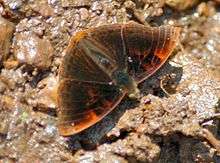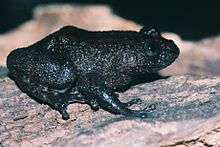Phansad Wildlife Sanctuary
Phansad Wildlife Sanctuary(Marathi: फणसाड वन्यजीव अभयारण्य) is a wildlife sanctuary in the Murud and Roha talukas of Raigad district, Maharashtra state, India.[1] It was created in 1986 to preserve some of the coastal woodland ecosystem of the Western Ghats and consists of 6,979 ha (17,250 acres) of forest, grasslands and wetlands. The area was once part of the hunting reserves of the princely state of Murud-Janjira.[2]
| Phansad Wildlife Sanctuary | |
|---|---|
IUCN category IV (habitat/species management area) | |
 Phansad Wildlife Sanctuary Location in India | |
| Location | Raigad District, Murud taluka and Roha taluka, Maharashtra |
| Nearest city | Alibag |
| Coordinates | 18°25′00″N 72°56′00″E |
| Area | 8436 hectares |
| Established | 1982 |

Geography
The Phansad Wildlife Sanctuary is located some 140 km (87 mi) from Mumbai. There are four main trails through the sanctuary that takes in the main waterholes, Gunyacha Maal, Chikhalgaan and Phansadgaan, that are some of the best places to see wildlife. The "Sacred Groves" is located near Supegaon. Pockets of open grassland, called mals, occur throughout the sanctuary. The sanctuary is best approachable by road from Murud-Janjira and Roha. The nearest rail head is Roha.
History
Before independence this sanctuary was private hunting Game reserve of Siddhi Nawab of Janjira State in Murud-Janjira. The entire area was notified as deemed reserved forest under section 4 of Indian forest Act, 1927 . The major part of the present day sanctuary was a part of Phansad working Circle.The sanctuary was declared on 25-2-1986 vide Government of Maharashtra notification WLP/1085/CR-75/F-5 Dt. 25.2.1986.[3] The final notification declaring eco sensitive zone around the Phansad sanctuary was made by Government vide Notification 105.S.O. 1603 (E) dated 17.05.2017.[4] The Eco-Sensitive Zone (ESZ) is spread over an area of 10.96 sq.km around the sanctuary. About 43 villages of Murud taluka and Roha taluka are part of the eco-sensitive zone.[5] The management plan for Phansad wildlife sanctury is approved vide letter Desk-22(8)/WL/M Plan/CR-166 Part14/2988/17-18 on 21/12/2017 for the year 2016-17 to 20125-26 by the Government of India[6]
Ecosystems
- coastal woodland ecosystem of the Western Ghats
Biodiversity
The sanctuary is rich in flora and fauna. The forest types are semi-evergreen, evergreen , Mixed deciduous and dry deciduous forests.
Faunal diversity
The sanctuary has a small population of Indian giant squirrel which is fragmented from the Western ghats. The fauna include 16 species of mammals, 62 species of birds, 17 reptiles, 47 incests and 27 marine invertibrates. The White-rumped vulture ((Gyps bengalensis) which is noted as critically endangered is also found in the sanctuary. [7] Representative fauna include:
- Indian giant squirrel (Ratufa indica)[1]
- muntjac (barking deer)
- hyena ((Hyaena hyaena)
- leopard or panther (Panthera pardus)
- Bombay earth snake (Uropeltis macrolepis) and
- Ceylon cat snake (Boiga ceylonensis)
- Sambar (Cervus unicolour)
- Mouse deer (Tragulus meminna)
- Python
Avifauna includes:
- Sri Lankan frogmouth
- Crested Serpent Eagle
Floral diversity
The forest on the top hill of the sanctuary are evergreen which include mostly Anjan (Memecylon umbellatum), Phansada (Garcinia talbootii) while those on the slopes are dry deciduous which include ain, kinjal, teak, hirda, jamba, mango, and various ficus.[1] The sanctuary has 710 species of Plants which include 179 species of trees, 66shrubs, 141 herbs etc (Marathe 2004).[7]
Gallery
Animals in the Sanctuary
Notes
- "Phansad Jungle". Rohan Gurao, Website for Roha.
- Puthran, Aayush. "Phansad Wildlife Sanctuary". India Travel. Archived from the original on 18 February 2013. Retrieved 4 January 2013.
- Maharashtra Forest Department, Government of Maharashtra. "Maharashtra Forest Department,". www.mahaforest.gov.in. Maharashtra Forest Department, Government of Maharashtra. Retrieved 9 December 2019.
- "Status of ESZ Notifications". www.rivermonitoring-up.in. Environment Directorate, Vineet Khand-1, Gomti Nagar, Lucknow. Retrieved 9 December 2019.
- Government of India. "The gazettee of India" (PDF). www.ercindia.org. Controller of Publications, The Government of India,Delhi-110054. Retrieved 9 December 2019.
- Maharashtra Forest Department. "List of Management Plan" (PDF). www.mahaforest.gov.in. Maharashtra Forest Department. Retrieved 9 December 2019.
- Shinde, Prashant. "Saving the White-rumped Vultures at Phansad Wildlife Sanctuary" (PDF). static1.squarespace.com. Srushtidnyan, Prashant Shinde. Retrieved 9 December 2019.
_Phansad.jpg)


.jpg)
